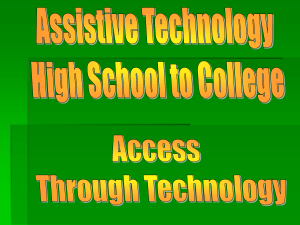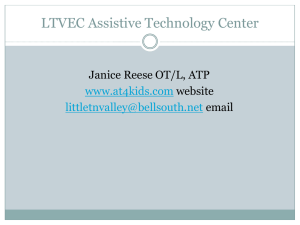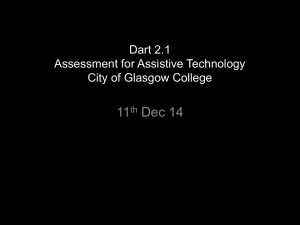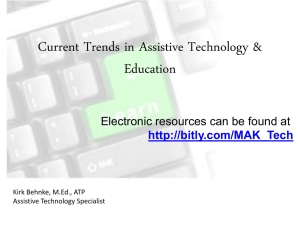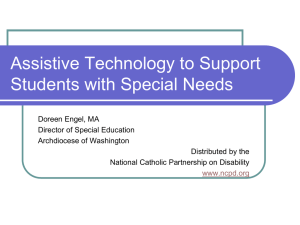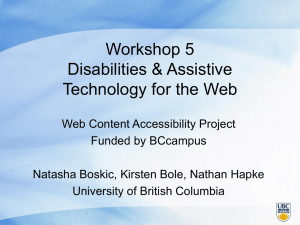AT from IRIS
advertisement
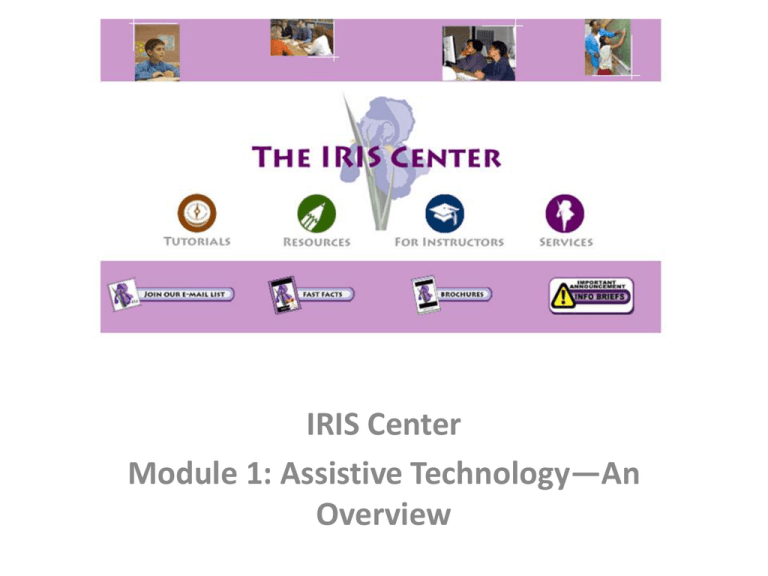
IRIS Center Module 1: Assistive Technology—An Overview Initial Questions • What should Ms. Adelaide know about assistive technology and how it is used by students with disabilities? • What are the school's responsibilities regarding assistive technology? • What can classroom teachers do to help their students fully succeed in their use of assistive technology? After reviewing the Perspectives and Resources section and after completing the accompanying activities, you should be able to: • Define assistive technology • Differentiate between assistive technology devices and assistive technology services • Understand how assistive technology helps students with disabilities gain access to the curriculum • Understand that the IEP team is responsible for considering assistive technology for students with disabilities • Access resources that support the use of assistive technology for students with disabilities What is AT? AT is any device or service that helps a student with a disability to meet his or her individualized education program (IEP) goals and to participate in the general education setting to the greatest possible extent. More simply, AT improves the functional performance of an individual with a disability. The Individuals with Disabilities Education Improvement Act of 2004 (IDEA '04) What is AT? Assistive technology, therefore, might be something as complex as a hand-held electronic magnifying instrument or as simple as a specialized rubber pencil grip. Students can utilize assistive technology to: • Communicate • Perform academic tasks • Participate in social and extracurricular activities • Move or travel around the school • Use proper seating and positioning • Access materials Our Old Friend Access Though assistive technology has the potential to improve both their quality of education and their quality of life, many students with disabilities simply do not have access to it. In order for school personnel to consider assistive technology, they must first understand assistive technology can come in the form of: • Devices • Services Assistive technology supports and services that are specified in the federal definition of assistive technology services include • Evaluating the student's need for a device • Buying, leasing, or acquiring the device • Selecting, fitting, adapting, repairing, or replacing the device as needed • Coordinating the services for a student who uses a device (e.g., therapies, education) • Providing training or technical assistance to the student, family, teachers, or others involved in the use of the device These include training on: • Using software and hardware across all environments (e.g., school, home, community) • Arranging the physical environment (e.g., ensuring that the physical space is set up to facilitate the most effective use of his AT) • Troubleshooting and making minor repairs to AT devices, including who to contact for technical support What are the school's responsibilities regarding assistive technology? Students must have access to needed AT if they are to ensure that all students have access to a free appropriate public education (FAPE). IDEA '04 requires IEP teams to consider… …whether AT devices and services are needed to accomplish the individualized goals and objectives for students with disabilities. Wisconsin Assistive Technology Initiative (WATI) Assistive Technology Consideration Guide One of the most commonly used or adapted AT consideration guides is the Wisconsin Assistive Technology Initiative (WATI) Assistive Technology Consideration Guide. Implementing AT • • • • Who is the contact person for coordinating efforts Who is on the Implementation Team and what are their roles What AT devices and services will be used How AT will be used across home, school, and community environments • How the student, teachers, and parents will be trained on AT • How AT will be monitored and evaluated Click to view or print the National Assistive Technology Research Institute's Assistive Technology Implementation Plan. As soon as the implementation of AT has begun, it is critical that information be gathered so the team can make informed decisions about what is working for the student. Some of the information that should be collected includes: • Student feedback to determine whether the student likes the AT and feels that it is helpful • Observations to establish whether the student uses the AT and appears engaged and interested in using the device • Performance data to determine whether the AT helps the student to perform the intended task(s) Some Reasons for AT Abandonment The student was not appropriately involved in the AT process (e.g., identifying or selecting the device). The AT is not supported in the environment. The device is too difficult to manage or use. Teachers think AT takes too much of their time. The AT does not do what it is expected to do. The AT device interferes with another AT device or some other task. The AT device is inflexible and not suitable for changing needs. That is, it does not grow with the student. The student is embarrassed or doesn't want to use something that makes him or her seem different from his or her peers. The device is not cool enough. The student may have a preconceived idea about the device.


